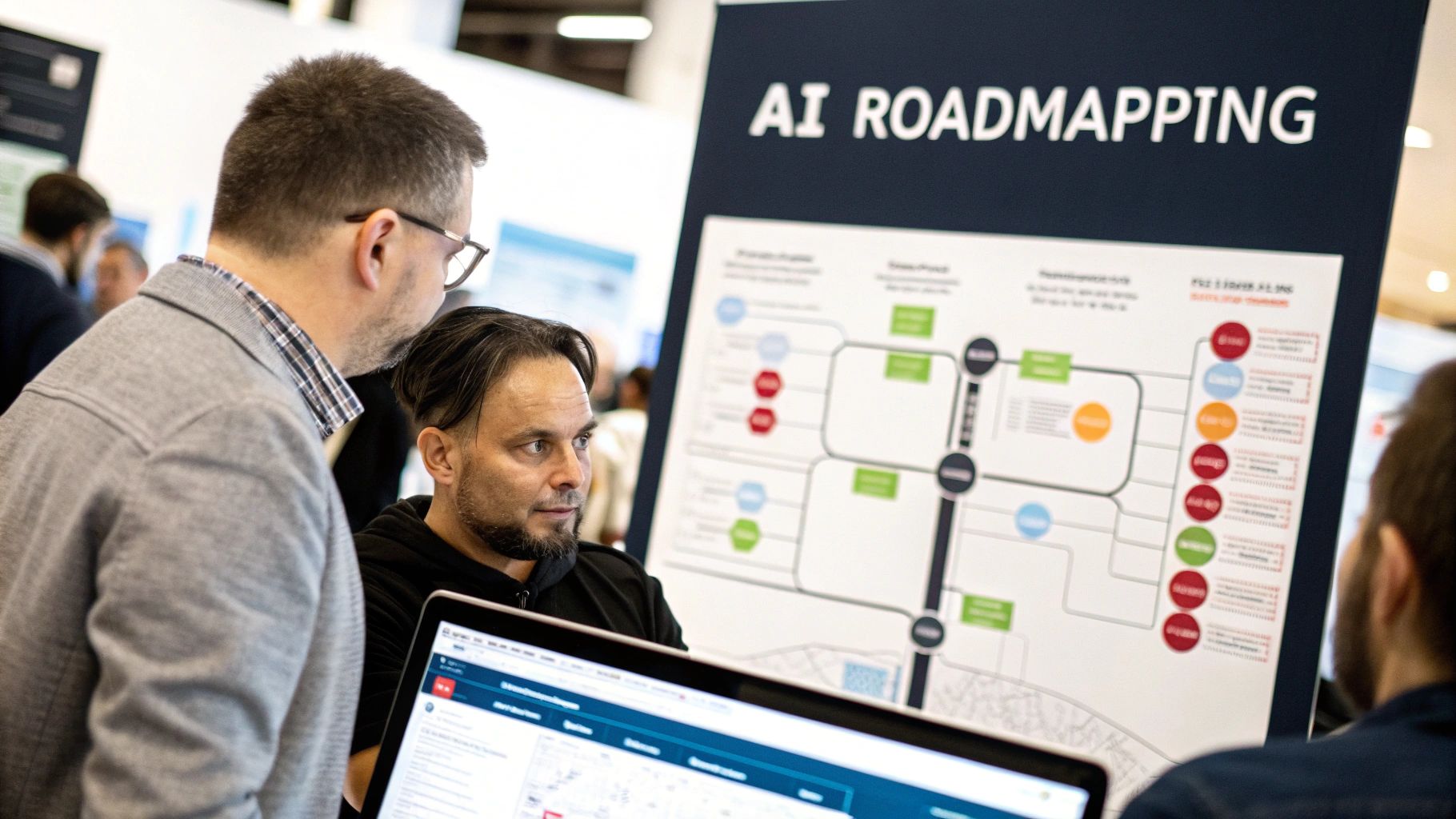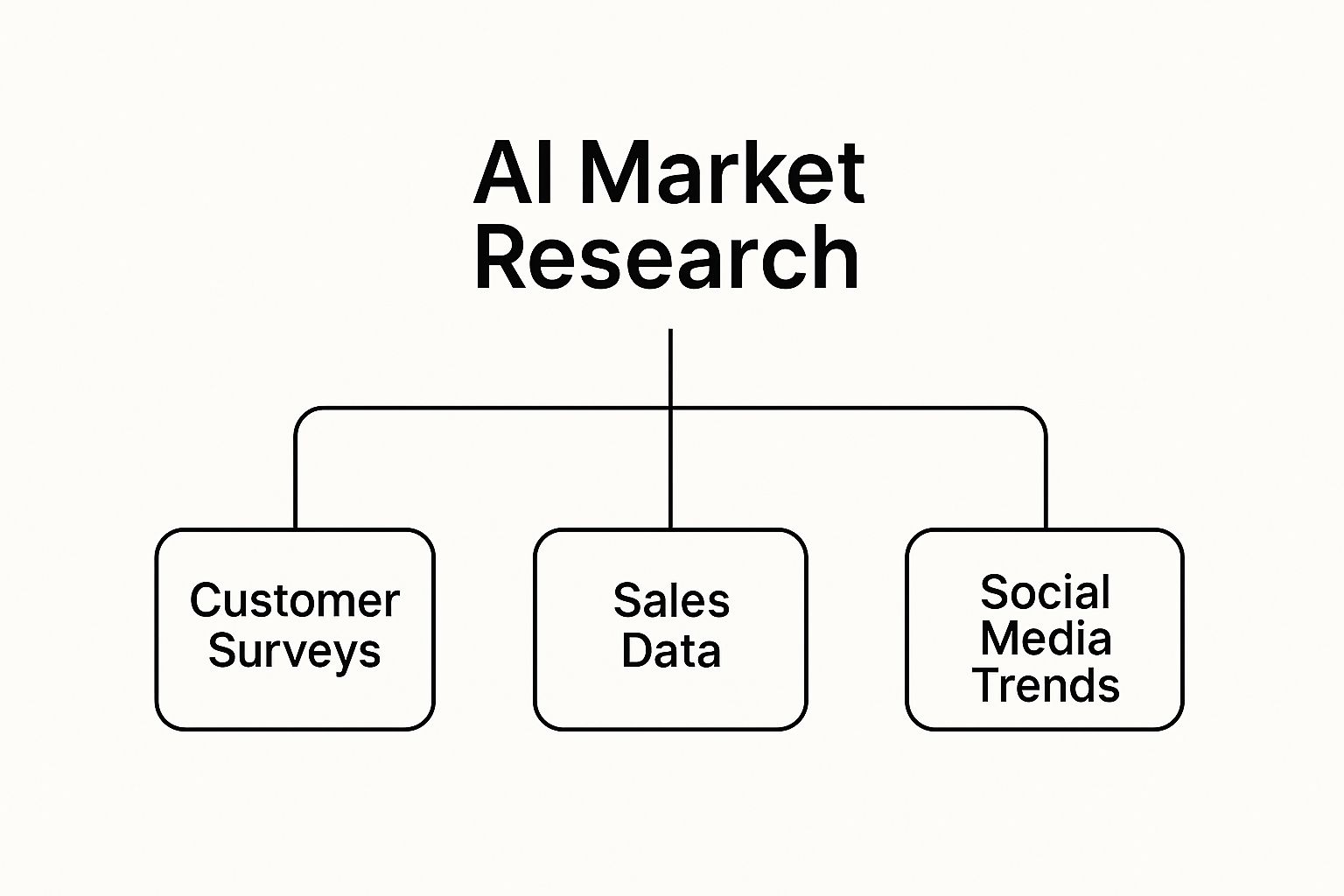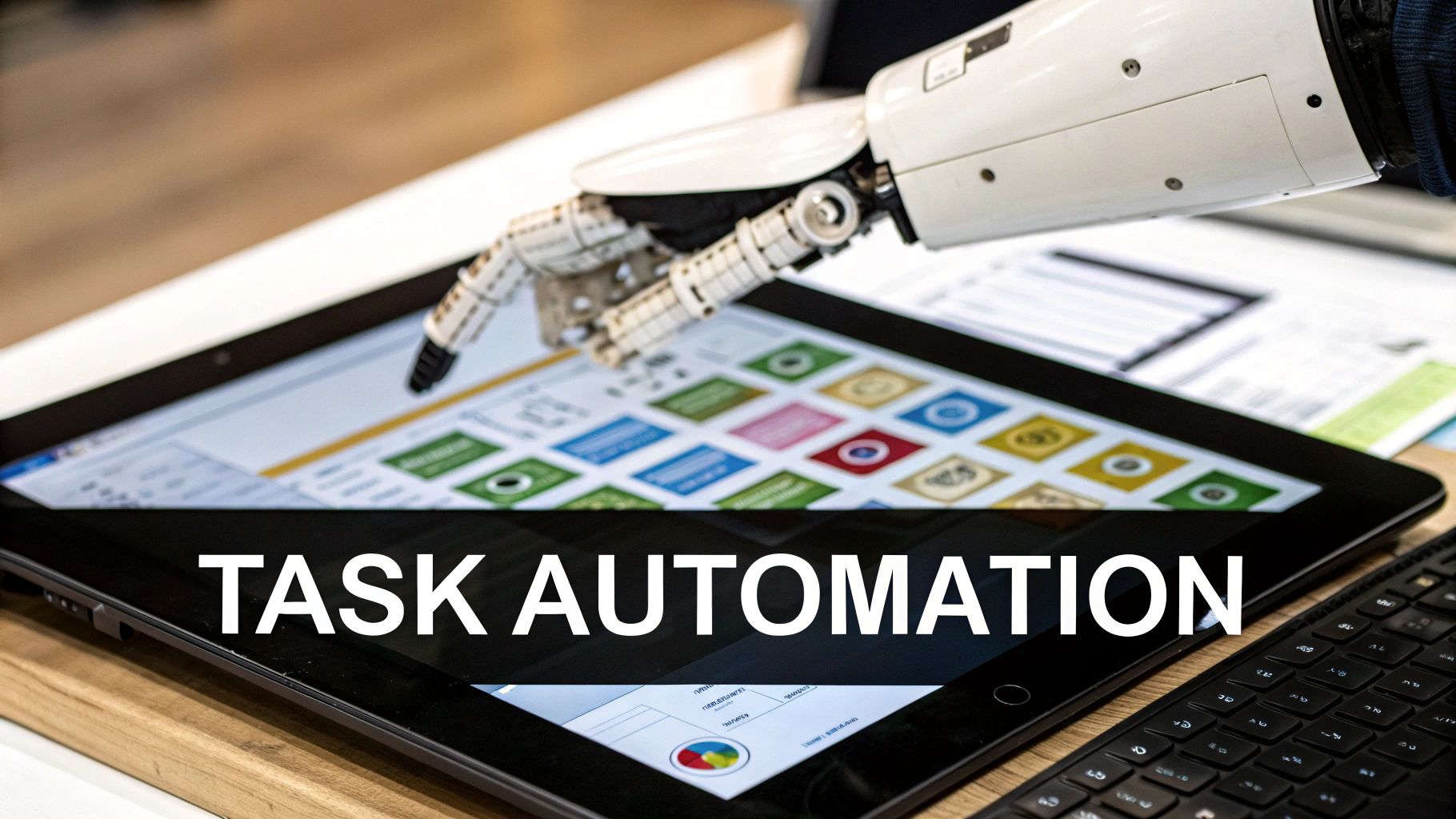Boost Innovation with AI for Product Management
Explore how AI for product management can enhance efficiency and drive innovation. Discover practical strategies to build better products today.

Sound familiar? You're staring down a mountain of user feedback, your calendar is a sea of meeting invites, and you're under constant pressure to make the right call. For most product managers, this isn't just a bad day—it's every day. You end up spending more time trying to organize the chaos than actually strategizing.
This is where AI for product management comes in, not as some far-off concept, but as a practical, tireless co-pilot. Its job is to sift through all that noise, handle the grunt work, and surface the insights you actually need to build great products.
Your New AI Co-Pilot in Product Management
Think of it like upgrading from a paper map in a rainstorm to a GPS with live traffic and weather updates. That's the kind of jump product teams are making right now. The daily grind for a PM is a massive balancing act, trying to keep stakeholders happy, analyze the market, and make sense of a constant flood of customer data. It's a role where the truly important signals are often buried under an avalanche of noise.
Let's be clear: artificial intelligence isn't here to replace the essential human intuition of a great product manager. It’s a force multiplier. It takes on the heavy lifting of data analysis and pattern finding—the kind of work that eats up your time and is easily swayed by unconscious bias.
By automatically digging through thousands of customer support tickets, sales call notes, and app store reviews, AI frees you up to do what you do best: focus on the strategic work that sparks real innovation.
Turning Data Overload into Clear Signals
The fundamental challenge has always been the same: how do you turn a messy pile of raw, unstructured data into a coherent product strategy? Without the right tools, it's a slow, manual, and often flawed process. You can spend days piecing together feedback from different channels and still only see part of the picture.
AI flips this script completely. It's like having an analyst on your team who never sleeps, connecting dots between different data sources that you might have easily missed. This gives you a single, clear view of what your customers need, where their pain points are, and what they truly want.
This guide isn't about the hype. We're going to take a practical look at how AI for product management actually delivers results. We’ll dive into real-world applications that make your workflow smarter and your decisions sharper. Forget the abstract theories—it's time to see how AI can help you build products that customers don't just use, but truly love.
How AI Actually Supercharges Your Workflow

To really get what AI for product management means, we have to move past the hype and look at what it actually does. Forget the technical jargon for a minute. Think of AI as having three distinct superpowers you can start using right away. Each one tackles a core challenge that every product manager knows all too well, giving you a real edge across the entire product lifecycle.
These aren't some far-off concepts from a sci-fi movie. They are practical tools that change how you discover, build, and improve your products. Once you understand them, you can pinpoint exactly where AI will make the biggest difference for you and your team.
The Power of AI Data Synthesis
Imagine having a research analyst who can read every single customer support ticket, interview transcript, social media mention, and competitor update—all overnight. The next morning, they hand you a perfect one-page summary highlighting the most urgent issues and hidden opportunities. That, in a nutshell, is AI-powered data synthesis.
Product managers are constantly drowning in qualitative data from a dozen different places. AI algorithms are brilliant at consuming this massive, messy information, spotting the recurring themes, and even gauging the sentiment behind it all. This lets you find the signal in the noise without spending weeks drowning in spreadsheets and sticky notes.
This isn't just about summarizing, though. It's about connecting the dots. For instance, an AI tool might link a spike in support tickets about a specific bug to a handful of negative reviews on a third-party site and a subtle drop in a key engagement metric. Suddenly, you have a complete, data-backed story of a critical issue you might have otherwise missed.
Automating Your Repetitive Workflows
Next, picture a tireless assistant who handles all the routine tasks that suck up your creative energy. This is the superpower of workflow automation. AI tools can now step in to manage the repetitive, process-driven parts of your job, freeing you up for the high-level strategic thinking you were hired to do.
Think about these common scenarios:
- Drafting User Stories: You dump in some rough notes from a brainstorming session, and an AI tool spits out well-structured user stories and acceptance criteria in your team's exact format.
- Generating Release Notes: Instead of manually compiling a list of updates, AI can look at recent code commits and Jira tickets to draft clear, customer-friendly release notes automatically.
- Summarizing Meetings: An AI agent can transcribe a stakeholder call, pull out the key decisions and action items, and have a draft follow-up email ready before you’ve even closed your laptop.
This isn't about replacing your judgment; it's about amplifying your capacity. You still provide the critical context and the final sign-off, but the tedious first draft is done for you.
Achieving Strategic Forecasting
The final superpower is strategic forecasting, which is kind of like having a crystal ball that’s grounded in data science. This involves using predictive analytics and machine learning to analyze market trends, user behavior, and historical data to forecast which features on your roadmap will actually deliver the biggest impact.
Instead of relying solely on gut feeling to prioritize, AI can help you answer critical questions with real data:
- Which of these proposed features is most likely to reduce customer churn?
- What’s the predicted adoption rate for that new premium tier we’re considering?
- Which customer segment will get the most value from our next big update?
The impact of these capabilities is already being felt. Product teams using AI are seeing a 43% increase in revenue-focused activities, saving an average of 18 hours per sprint, and cutting down on unnecessary meetings. A huge reason for these wins is AI’s ability to analyze unstructured data from sources like customer feedback and support tickets up to 10 times faster than old-school methods. You can explore the latest insights on this from BuildBetter.ai.
Putting AI to Work in the Product Lifecycle
Theory is one thing, but seeing AI for product management in action is where its value really clicks. This isn't about some single, magic-bullet tool. Instead, think of AI as a set of specialized assistants that can give every stage of your product lifecycle a serious boost.
From that first spark of an idea all the way to post-launch tweaking, AI brings the data-driven clarity we need to build products people actually want to use.
Let's walk through the product development journey, step by step, to see where AI makes a real, tangible difference.
Fueling the Discovery Phase
The discovery phase is all about finding and validating the right problems to solve. We’ve all been there—manually sifting through interview notes, survey results, and a mountain of support tickets. It's slow, tedious work, and it's dangerously easy for our own biases to take over, letting the loudest customers drown out the most critical feedback.
AI completely flips this script.
Imagine an AI that reads through thousands of customer conversations from sales calls, support chats, and feedback forms in minutes. It can instantly spot recurring themes, highlight unmet needs, and even flag new pain points before they snowball into bigger problems. You’re no longer working with a small, potentially skewed sample; you get a bird's-eye view of your entire user base.
For example, an AI tool might unearth a gem like this: 15% of trial users who mention "confusing navigation" during onboarding are 80% more likely to churn in their first week. That’s not a vague hunch. It’s a quantifiable, actionable insight that points your team directly to a high-impact problem worth solving.
This image shows how AI can pull together different data streams for a much richer understanding of the market.

By weaving together inputs from surveys, sales data, and social media, AI gives you a complete picture of the landscape, moving you way beyond isolated data points.
Sharpening Planning and Prioritization
Okay, so you've found a solid problem. Now comes the hard part: deciding what to build and when. Too often, roadmap planning becomes a battle of opinions, where the "highest-paid person's opinion" (HiPPO) wins the day. AI helps us move away from gut feelings and toward an objective, data-backed framework.
You can use AI models to score and rank potential features against your actual business goals. Just feed them the variables—things like expected impact on retention, estimated engineering effort, and alignment with your quarterly OKRs. The AI then spits out a priority score for each item. Suddenly, you have a roadmap that’s directly tied to business value.
This data-first mindset ensures your team's precious time and resources are always focused on the work that matters most.
Streamlining the Development Sprint
Once development is underway, clear communication and alignment are everything. A simple misunderstanding between product, engineering, and design can lead to painful delays and wasted work. This is where AI can step in as a brilliant communication hub and productivity multiplier for the whole team.
Here are a few ways AI for product management can help during a sprint:
- Drafting Technical Specs: A product manager can outline a user story, and an AI assistant can generate a solid first draft of the technical specs—complete with API endpoints and data schema suggestions—giving engineers a huge head start.
- Summarizing Stand-ups: AI can transcribe daily stand-up meetings, automatically identify blockers, and send a summary to stakeholders who couldn't be there. Everyone stays in the loop without yet another meeting cluttering the calendar.
- Clarifying Requirements: When an engineer has a question about a user story, they can ask an AI bot that’s been trained on all the project documentation. They get instant answers instead of having to track down the PM.
Accelerating Launch and Iteration
The job isn't done when the product goes live—far from it. The launch and iteration phase is a continuous cycle of learning and improving. AI just makes that cycle run a whole lot faster and smarter.
The moment you launch, a flood of new feedback pours in from App Store reviews, social media, and support channels. Trying to analyze all of that manually would take days. AI can do it in minutes.
Sentiment analysis tools can instantly gauge user reactions, flagging whether the overall response is positive, negative, or somewhere in between. More sophisticated AI can even categorize the feedback into themes like "bugs," "feature requests," or "usability issues."
This gives you an immediate, real-time pulse on your launch. If a critical bug is causing widespread frustration, you'll know in hours, not weeks, allowing your team to jump on it right away. This rapid feedback loop is the lifeblood of agile iteration, helping you make the small, continuous improvements that keep customers happy and engaged.
To bring this all together, here’s a quick overview of how AI tools can be applied across the entire product lifecycle.
AI Applications Across the Product Lifecycle
| Lifecycle Stage | AI Application | Primary Benefit |
|---|---|---|
| Discovery | Analyzing user feedback (surveys, interviews, support tickets) | Uncovering hidden pain points and validating problems at scale. |
| Planning | Scoring features against business goals (e.g., revenue, retention) | Removing bias and enabling data-driven roadmap prioritization. |
| Development | Generating user stories, technical specs, and test cases | Accelerating sprint velocity and improving team alignment. |
| Launch | Monitoring social media and app reviews for sentiment analysis | Gaining real-time insight into market reception and critical issues. |
| Iteration | Identifying user segments for A/B testing and personalization | Running smarter experiments and delivering more relevant experiences. |
This table illustrates that AI isn't just for one department or one task; it's a versatile toolkit that provides tangible advantages from the first brainstorming session to the hundredth product update.
Tying AI Adoption to Real Business Value

It's one thing to talk about efficiency gains, but getting budget approval means connecting AI for product management to the metrics that really move the needle for leadership: revenue, retention, and market position. So, how do you build a business case for AI that actually gets signed off on? It all starts by reframing the conversation away from "hours saved" and toward tangible financial outcomes.
The real value isn’t just in making your team faster; it’s about making your entire product strategy smarter. AI gives you the hard data to move past anecdotal evidence and gut feelings, letting you justify development costs and prove its worth directly on the balance sheet.
Beyond Efficiency to Nailing Product-Market Fit
One of the biggest, and often invisible, drains on a product team's budget is building features that nobody uses. These "zombie features" chew up huge amounts of resources—engineering time, design cycles, marketing spend—only to be met with a collective shrug from customers. This is where AI delivers one of its most powerful returns.
AI-driven insights can drastically cut down the risk of building the wrong thing. By digging through mountains of user behavior data, customer feedback, and support tickets, AI can spot the specific pain points and desires that matter most to your high-value customers.
Instead of just guessing what might improve retention, you can pinpoint the exact friction points causing churn. That focus ensures every dollar spent on development goes toward work that strengthens product-market fit, which translates directly to higher adoption rates and a healthier bottom line.
Driving Revenue with AI-Powered Personalization
Today’s customers don’t just want products that work; they expect experiences that feel like they were made just for them. AI is the engine that makes this possible, creating stickier products that keep people coming back—and, crucially, spending more.
Just look at the recommendation engines from Netflix or Spotify. They don't just throw content at you; they curate a personal journey that keeps you engaged and builds loyalty.
This isn't just for media giants. The same logic applies to any SaaS product. AI can help you:
- Surface the right features to the right users at exactly the right moment.
- Spot upselling opportunities by predicting which customers are ready for a premium plan.
- Tailor onboarding flows to slash early-stage churn and get users to that "aha!" moment faster.
Every one of these actions directly boosts Customer Lifetime Value (CLV), a metric that gets any executive's attention. With the global AI industry valued at around $391 billion and projected to grow fivefold in the next five years, the case becomes even stronger. In fact, 83% of companies now see AI as a top strategic priority. At this point, not adopting it is starting to look like a competitive risk. You can discover more insights on the rapid growth of the AI market and what it means for business strategy.
Accelerating Your Time-to-Market
In a crowded market, speed is your best weapon. The faster you can ship valuable features to your customers, the more ground you can gain on competitors. AI acts as a powerful accelerator across the entire development process, breaking down the bottlenecks that slow teams down.
Decision-making gets a lot quicker when it's backed by data instead of endless debates. Rather than spending weeks in meetings arguing over the roadmap, AI can score and rank initiatives in minutes. This agility lets your team react to market shifts and customer feedback with incredible speed.
This faster cycle doesn't just get you to launch sooner; it creates a much tighter feedback loop. Quicker releases mean faster learning, and that learning feeds right back into a smarter, more responsive product strategy. In the end, investing in AI for product management isn't just about getting a new tool—it's about building a more resilient, competitive, and profitable business.
How to Integrate AI Into Your Product Team

Bringing AI into your product management process isn't just about buying a new subscription. It's a real shift in how your team thinks and works. To do it right, you need a plan—one that marries the right technology with the very human process of change. Without a clear strategy, even the most impressive tool will just sit on the shelf.
The journey starts with a hard look in the mirror, not a sales demo. You have to figure out where the biggest logjams are in your current workflow. Where is your team burning hours on tasks that don't move the needle? Maybe it’s the mind-numbing process of manually tagging thousands of user feedback tickets. Or perhaps it's the circular debates about what to build next, fueled more by opinions than by actual data.
When you pinpoint these specific pain points, you have a clear problem to solve. That clarity acts as your compass, guiding your search and keeping you from getting sidetracked by shiny features that don’t actually help your team.
Selecting the Right AI Tools for Your Team
Once you know what you’re trying to fix, you can start looking at potential solutions. But let's be clear: not all AI tools are built the same. You need a way to evaluate them that goes beyond a simple checklist of features.
Here are the key things I always look for when choosing an AI platform:
- Problem-Solution Fit: Does this tool solve the exact bottleneck you identified? Don't get drawn into a complex, all-in-one platform if a simpler, focused tool gets the job done better.
- Integration Capabilities: How well does it play with others? A new tool has to plug seamlessly into your existing stack—think Jira, Slack, Zendesk, or your CRM. If it creates more friction, it’s a non-starter.
- Data Security and Privacy: Your customer data is gold. You must ensure any vendor has ironclad security protocols, meets compliance standards like GDPR or SOC 2, and is completely transparent about how they handle your data.
- Scalability: Pick a tool that can grow with you. The last thing you want is a system that buckles under the pressure of more data and more users a year from now.
Driving Adoption and Managing Change
Honestly, the biggest challenge is rarely the technology itself—it's the people. Getting your engineers, designers, and leadership on board is absolutely essential. You can't just drop a new tool in their lap and expect them to use it.
You have to be the champion for this change. That means starting with the "why." Clearly explain how this new tool makes life better for them. For engineers, that might be clearer user stories backed by solid data. For designers, it could mean building much richer user personas from thousands of real customer interactions.
The secret to getting people on board is to show them a quick win. Start with a small pilot program. Find an enthusiastic group to test the tool, iron out any issues, and rack up some early success stories. Those stories become your most powerful internal marketing, building the momentum you need for a full rollout.
This mindset is catching on across the industry. In fact, 76% of product leaders are planning to increase their AI spending in the next year. This isn't just trend-chasing; it reflects a growing understanding that AI helps teams move beyond just shipping features and start optimizing for real user value and business impact. As some excellent research from Airtable points out, AI-powered strategies are quickly becoming the new normal.
The Future of Product Management with AI
The question comes up in almost every product team meeting these days: "Will AI replace product managers?" It's a fair question, but the reality is a lot more interesting than that. The future isn't about replacement; it’s about elevation. AI is shaping up to be the ultimate partner, a tool that can finally take on the tactical busywork that eats up a PM's day, freeing them up to do what they do best.
Think of it less as a threat and more as an AI co-pilot. This assistant can tirelessly crunch numbers, whip up reports, and analyze thousands of data points while you sleep. All that grunt work that gets in the way of real strategic thinking—like manually pulling data from six different sources or writing routine status updates—gets delegated. This gives you back your most precious resource: time.
This change shifts the entire role, moving it from a tactical "doer" to a genuine strategic leader. The most successful PMs won't be the ones who resist this; they'll be the ones who master the partnership.
From Tactical Execution to Strategic Vision
At its heart, product management will always be about uniquely human skills that a machine just can't copy. With AI taking on the heavy analytical lifting, PMs can finally double down on the things that truly drive innovation.
Imagine what you could do if you had the headspace to focus completely on:
- Deep Customer Empathy: Spending more quality time actually talking to users, watching them work, and picking up on those subtle, unspoken needs that raw data can never show you.
- Creative Problem-Solving: Getting out of the weeds of optimizing existing features and into the blue sky of dreaming up entirely new solutions and business models.
- Crafting a Compelling Vision: Building and telling a powerful story about your product that gets the entire company, from engineering to sales, fired up and aligned.
This isn't some far-off dream. We're already seeing the first versions of AI systems that can run autonomous user research simulations or predict potential roadmap blockers before they can ruin a sprint. It's happening now. In fact, a report from McKinsey found that AI has already boosted product manager productivity by as much as 40%. That’s a clear sign of just how powerful this partnership can be.
The most impactful product managers of tomorrow won't be replaced by AI. They will be the ones who learn to command it, using it to amplify their strategic judgment and creative instincts. The goal is to let the machine handle the 'what' so you can focus on the 'why'.
The core of the job isn't changing: understand people, find their problems, and build something valuable. AI is simply becoming the most powerful tool we've ever had to do that job at a scale and speed we couldn't have imagined before. The future of AI for product management isn't about artificial intelligence; it's about augmented intuition.
Ready to transform your qualitative feedback into revenue-driving insights? SigOS uses AI to analyze customer data and connect it directly to business impact. Prioritize your roadmap with confidence.


